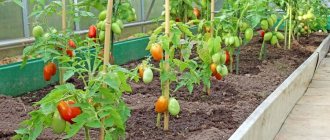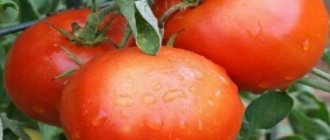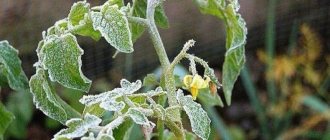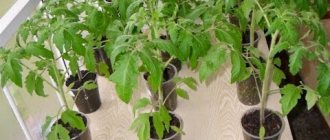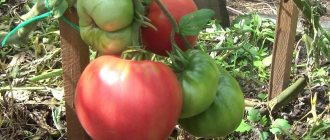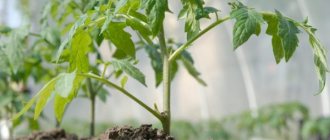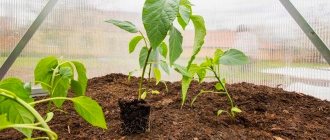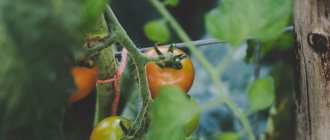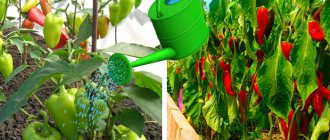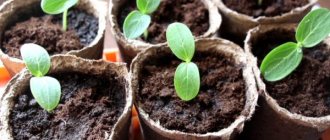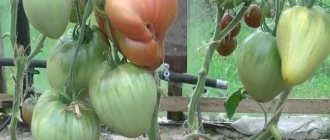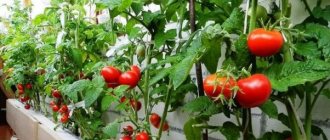Tomatoes are a heat-loving vegetable crop. They are one of the most popular vegetables grown in summer cottages.
Unfortunately, not many people know how important it is to adhere to a certain temperature in order to obtain its seedlings. The further development and fertility of the plant depends on this.
The importance of temperature conditions when growing tomato seedlings
Many inexperienced gardeners, hoping for an early harvest, rush to sow tomato seeds. The result of haste is weakened seedlings and complications in care.
Features of the influence of temperatures on tomato seedlings:
- To avoid problems associated with temperature conditions, seeds should be sown no earlier than mid-March.
- If seedlings are exposed to critically low temperatures, not only the above-ground part suffers, but its root system also dies. After this, plant restoration becomes impossible.
- At each stage of development, seedlings require a certain temperature regime.
Preparation of seed material
Before sowing tomato seeds, it is advisable to prepare them at low temperature, that is, harden them. Many gardeners warm up and then harden the seeds before sowing. After heating and hardening, the seeds germinate evenly and quickly, which is how healthy and strong seedlings are grown. In addition, it was noticed that heated seed material reduces the permissible temperature regime for tomato seedlings and significantly increases the overall yield of adult tomatoes.
There are several options for warming up:
- In winter, regardless of the expected date of sowing the seeds, it is convenient to heat them on a heating radiator. Tomato seeds are poured into a cotton bag and hung near the radiator for 1.5-2 months. This way you will get rid of the hassle and will be able to warm the seeds well;
- The seed is heated using a simple table lamp. A sheet of paper is spread on an inverted lampshade and tomato seeds are poured out. Everything must be covered with a paper cap and kept there for 3 hours;
- You can heat the seeds in the oven. They are spread in a thin layer on a baking sheet and placed in the oven, preheated to 60 degrees. So they are kept for 3 hours, stirring the seeds regularly;
- Right before germination, the seeds are heated in warm water. They are poured into a rag bag and immersed in water for 3 hours at a temperature of 60 degrees. You can maintain the required temperature by adding a little boiling water.
- There is a more effective way to treat seeds with heat. They are processed using variable temperatures - tomato seeds are kept for two days at +30 degrees, then 3 days at +50 degrees and 4 days at +70-+80 degrees. When heating the seeds for a long time, you need to raise the temperature gradually. This temperature regime allows you to obtain plants that tolerate drought well.
You need to warm up both your own seeds and those purchased in the store. This operation increases the sowing characteristics of tomatoes and provokes earlier fruiting.
Cold treatment also prepares the seeds for unfavorable conditions. After this, seedlings resistant to low temperatures grow and the plants become more viable. After hardening, the tomato seed quickly germinates and forms uniform shoots, which allows plants to be transplanted into the garden much earlier than without such treatment. The minimum temperature that tomato seedlings can withstand changes.
To harden, place tomato seeds in a damp cloth and then place them in a plastic bag. This package should be placed on the bottom shelf of the refrigerator. Under these conditions, the seeds will lie for 12 hours, then they are transferred for 12 hours to conditions where the temperature is maintained at +15-20 degrees, after which they are returned to the refrigerator again.
This method of seed hardening is continued for 10-15 days. It is possible that tomato seeds will begin to germinate earlier, in which case the period of heating and cooling should be reduced by 3-4 days.
Remember! When hardening, you can add nutrients, growth stimulants and various biological products to the solution, for example, infusion of ash or succinic acid.
Air temperature requirements
In order for seedlings to grow viable, certain temperature conditions are created for them corresponding to the stage of development.
When planting seeds
The seeds are germinated before sowing. This procedure increases their germination rate. Planting material is germinated at temperatures from +25 to +30 °C. At lower values, seeds will germinate much more slowly.
To ensure optimal temperature conditions, germinated seeds are placed on a radiator. It is important to promptly moisten the fabric in which the planting material is wrapped.
When the seeds are sown in the ground, the temperature in the room is maintained from +24 to +26 °C.
How to ensure the required conditions:
- Cover the box with the seeds with film.
- Place foam under the bottom of the box.
- Windows should provide maximum light, so boxes with crops should be placed on the south side.
After germination
When seedlings appear in the seedling boxes, the temperature is adjusted in such a way as to grow the strongest seedlings.
Temperature conditions after germination:
- First week. Maintaining low temperatures during the first week after germination helps prevent sprouts from stretching. Recommended temperatures:
- daytime – from +13 to +18 °C;
- night – from +11 to +14 °C.
- Second week. The temperature is gradually increased. Recommended values:
- on clear days – from +20 to +23 °C;
- in cloudy weather – from +18 to +20 °C;
- night – from +17 to +19 °C.
Many experienced gardeners adhere to other rules; they believe that temperatures should be lower:
- in cloudy weather – from +16 to +19 °C;
- at night – from +10 to +13°C.
Extreme caution must be taken as the temperature drops. Even a loss of 2-3 degrees Celsius can negatively affect seedlings.
A slight drop in temperature can provoke:
- weakening of the root system;
- developmental delay, which will negatively affect productivity.
Overheating has an equally detrimental effect on the development of seedlings. The sprouts stretch out, their stems become thin and weak.
At this stage, daylight hours should be at least 10 hours. If there is not enough light, turn on the lamps. The soil is moistened with a spray bottle, avoiding stagnation of water.
After the pick
If the seeds were sown in a common container, the seedlings have to be picked - planted in separate 0.5 liter glasses.
Recommended temperatures after picking:
- on clear days – from +20 to +23 °C;
- in cloudy weather – from +16 to +18 °C;
- night – from +12 to +15 °C.
Lighting
Mature tomatoes, for example the Beef variety, are not very demanding on daylight hours, which is proven by the possibility of growing the crop even in regions where the amount of daylight is quite small. Despite these properties of the tomato, it is very important for seedlings that the plant receives a sufficient amount of light in a certain spectrum. For active growth, red light sources are used, as they stimulate growth and provide plants with the need for ultraviolet rays.
Length of daylight: how much light is needed and how additional lighting is carried out
Each growth phase has its own daylight hours:
- The first few days after germination lasts around the clock.
- A few days after germination, when the plant enters the seedling phase, 16 hours of daylight are provided.
- After picking the seedlings, that is, after 14-15 days, the sprout also needs 16 hours of light over the next 15 days.
- In the interval between 30 and 60 days, the daylight hours for a tomato sprout are 14 hours.
How to illuminate tomato seedlings at home: artificial lighting
As it was already found out earlier, tomato sprouts need to be illuminated for a long time. To determine how to properly make a lighting system, it is necessary to consider that light power is measured in lumens. Anzur will tell you about growing and caring for onions in this link.
The more lumens, the more light.
Lamps for illumination or supplementary lighting
A common type of lamp used for growing tomatoes is the incandescent lamp. They provide enough heat, but at the same time have a fairly low learning curve, so they are ineffective. Another popular grow light is the halogen light. It is durable and has good light output.
When creating a system, it is better to place the lamps in such a way that the light flux goes at a right angle to the growing seedlings.
When creating professional lighting systems, other types of lamps can be used:
- incandescent lamps - rarely used due to low light output of 17 lm/watt;
- xenon - produce blue light with a luminous efficiency of 70 lm/watt;
- luminescent - their indicators in lumens are 70-100 lm/watt;
- linear - oblong fluorescent lamps with a diameter from 16 to 26 mm. Among the varieties are light output with a red or blue spectrum, which have a positive effect on photosynthesis. The spectrum varies from 47 to 100 lm/watt;
- high-pressure sodium lamps - mainly produced with a red spectrum of light, used to strengthen the root system, form buds and during the flowering period. Such lamps are used for seedlings from 30 to 60 days after germination. Light output - 200 lm/watt. There are modified models with DNAT that have a mirror finish. Their benefit is that they work longer, and the efficiency is up to 95%;
- metal halide or DRI lamps are the most effective phyto lamps among gardeners. Their light output is up to 100 lm/watt;
- LED - and these lamps are the most popular among gardeners due to their quality ratio to energy consumption and efficiency. They can be used everywhere and do not require complex installation.
The influence of different temperatures on seedlings
Tomato seedlings are very sensitive to the slightest temperature fluctuations. Low and high temperatures are equally harmful to tomato seedlings.
Violation of the temperature regime leads to:
- to a decrease in yield;
- deterioration of immunity.
Low temperatures make the plant stem thick and short, high temperatures make it thin and long.
Maximum
Reaction of seedlings to high temperatures:
- Early flowering and fruiting, which subsequently leads to a decrease in yield.
- At temperatures above +28 °C, seedling growth stops. When the temperature rises to +40 °C, the seedlings die.
Minimum
Reaction of seedlings to low temperatures:
- At temperatures below optimal, the growth of seedlings slows down, but in the future this has a positive effect on the yield (provided that the temperature drop is not critical).
- If the temperature drop is critical, the tomatoes bear fruit late and there are fewer fruits than expected. Tomatoes turn out tasteless - they have little sugars and fruit acids.
- At temperatures below +13 °C, seedling growth stops. Pollen sterilization is observed.
- If the temperature drops to +5 °C, the plant stops developing and is on the verge of death.
Ground temperature for planting tomatoes
If you plant seedlings in insufficiently warmed soil, this leads to a natural slowdown in their growth. The seedlings are very poorly accepted in a new place, they remain lifeless and lethargic for a long time, and the roots acquire a bluish tint. Even with subsequent warming, overcooled plants remain extremely vulnerable to common diseases, yields are reduced, and the crown is formed with distortions.
Seedlings should receive nutrients from the soil, as well as the moisture they need for growth, but the exact opposite process occurs. The root system is quickly depleted, the crown of the bush becomes very sluggish, the stem becomes thinner, and the leaf acquires an ugly yellow color. You can revive your planting even in such a situation, but you still won’t be able to achieve the expected harvest. And what does grow will ripen much later than it could have been under normal conditions.
Soil temperature
In addition to air temperature, soil temperature is also important for the growth of tomato seedlings.
The influence of soil temperature on seedling growth:
- Cool soil slows down the growth of seedlings. The seedlings wither and their root system freezes.
- Seedlings that have managed to survive the adverse effects of cold soil become vulnerable to disease.
- Excessively warm soil causes plants to wither, their stems become thinner, and the leaves turn yellow. Even if the plants move away, their fruiting will deteriorate.
Soil temperature for tomato seedlings:
- Optimal – from +20 to +22 °C.
- Limits:
- minimum – below +16 °C;
- maximum – above +30 °C.
The minimum soil temperature for planting seeds is +18 °C.
If the soil temperature is less than +16 °C, the seedlings will stop absorbing nitrogen and phosphorus. Its roots will stop developing and the plant will eventually die.
How to germinate seeds
It is advisable to germinate the seeds before sowing. They may hatch during hardening, but if this does not happen, then the seeds should be placed in a warm and humid environment.
The optimal temperature for tomato seedlings is within +25-+30 degrees. This may be a place near the radiator, or above the gas stove.
Attention! In a humid place where the temperature is maintained at about +25 degrees, tomato seeds sprout in just 7-10 days.
Rules for adjusting the optimal air temperature
Maintaining temperature within specified limits when growing seedlings is a very troublesome task. You should hang a thermometer in the room to help control the temperature.
Temperature adjustment methods:
- If the air temperature has dropped, it is necessary to increase the heating of the room. If the heating is autonomous, increase the temperature, if centralized, turn on the heater.
- If seedlings are grown in a greenhouse, the temperature is controlled using fluorescent lamps. If it is necessary to lower the temperature, ventilation is activated in the greenhouse.
- In cloudy weather, it is useful to turn on lamps; they not only provide light, but also warmth.
- Boxes with seedlings can be lined with foam plastic - it helps to retain the heat of the soil.
- If the temperature drops significantly, the boxes with seedlings can be covered with transparent plastic film or other material that transmits light.
Conclusion
Polypropylene (general designation - PP) is today the most common material for the manufacture of water pipes. This “popularity” is due to a number of factors:
- Low cost, which allows significant savings when installing a water supply system.
- Easy soldering, making it possible to do the installation yourself.
- Long service life, reaching over 50 years.
But the main property of polypropylene, which distinguishes it from many other polymers, is excellent thermoplasticity. That is, when heated, this material can easily transform into a soft state, and when cooled, it can harden again. Thanks to this, the simplicity of assembling water supply systems from PP pipes is achieved: the ends of the parts are simply heated and connected to each other using special couplings, or by direct joining.
As you can see, PPR pipes are best suited for cold water supply. But if necessary, they can also be used for hot water. In this case, attention should be paid to the marking, since the maximum operating temperature of polypropylene pipes directly depends on their production technology.
Hardening of seedlings before planting in the soil
Seedlings must be hardened off before planting in the soil. Effect of procedures:
- hardening allows you to prepare plants for new conditions, so after transplantation they adapt faster and develop better;
- plant immunity increases;
- seedlings tolerate low temperatures better.
Features of hardening tomato seedlings:
- Hardening begins after picking, 2-3 weeks before transplanting into the ground.
- Containers with seedlings are taken outside daily. At first, the “walks” last about half an hour. They are gradually increased to 2-3 hours.
- Take the seedlings outside only in calm and sunny weather.
- Seedlings should not be taken outside if the temperature drops below +10 °C.
- When taking them outside, do not place seedlings in a draft.
Hardening is not a mandatory event. It is carried out depending on the conditions in which the crop will grow. If there is a hot summer ahead and no frost is expected, it is better not to harden.
Restrictions on use
Since the entire water supply system operates under pressure, there is a possibility of damage to the heated pipeline under its influence. Even deformations of pipelines are extremely undesirable for users.
Therefore, the manufacturer sets a restriction on the use of polypropylene pipes for hot water supply. The coolant temperature should not be more than 95⁰С.
So what temperature does the water flow in our pipes?
In order to understand this issue, let’s see what the current regulations say about this.
SP 30.13330.2012 “SNiP 2.04.01-85 * Internal water supply and sewerage of buildings” states that the water temperature for residential apartment buildings and public premises should not be higher than 75⁰C. And in the premises of preschool institutions in places where water is collected, the temperature is not higher than 37⁰С.
With hot water supply systems everything became extremely clear.
The situation is completely different with water heating systems.
Saving seedlings from heat and cold
Cold and heat await the seedlings immediately after planting in the ground. Depending on the climate and weather conditions, seedlings planted in the ground may experience both the force of frost and the destructive effects of the sun.
Heat protection:
- Spunbond. Thanks to the artificial shelter, the seedlings are protected from the heat. The material is breathable, so plants can breathe freely. But the sun's rays, which can burn the leaves of seedlings, do not pass through the spunbond.
- Mulching. It prevents the soil from drying out and overheating. The mulch is poured in a layer of 4-5 cm.
- Planting tall plants. This event is for the future. As the tomatoes grow, they will be protected from the sun by tall stalks of corn or climbing grapes.
If you do not take care of protecting seedlings planted in the ground, your work may be in vain. Even a slight drop in temperature can kill seedlings.
Frost protection:
- Make a film cover. The film is stretched over the arcs. You can cover each plant separately, for example, with plastic bottles.
- Cover the plantings at night with spunbond.
- Mulch the beds. A layer of mulch traps heat in the soil.
If frosts occur even in summer, then it is better to plant seedlings not in open ground, but in a greenhouse. In particular, this method of cultivation is suitable for the northern regions and Siberia.
At what temperature do tomatoes grow?
If the greenhouse is small, then there is always the danger of too sudden transitions from heat to cold. This is a critical disadvantage of all greenhouses, which is almost impossible to correct. That is why they are recommended for use in those regions where spring still comes early. In cold areas, where prolonged frosts are quite possible even in May, it is still better to glaze the greenhouse.
Modern technology makes it much easier for the gardener to care for seedlings. So, using automation, you can set the opening/closing mode of the windows. They need to close when the air temperature drops below +18°C, and open when heated above +25°C. Under such conditions, the risk of overheating or hypothermia is minimized.
Important! It is known that tomato bushes are able to survive even in heat up to +40°C. But this does not benefit them. It has been established that when the air is heated to more than +35°C, the process of pollen maturation stops, as well as pollination. If an increase in temperature is detected, it is best to immediately open all doors and windows to create the strongest possible draft. All plants urgently need to be watered abundantly. This will reduce the temperature by approximately 9°C.
Even young plants are not afraid of drafts; on the contrary, the benefits of a fresh breeze, which will clean the air and lower the humidity in the greenhouse, are very significant. If the humidity is too high, then the pollen simply will not be able to detach itself from the stamen and transfer to the pistil, even in self-pollinating varieties. Open windows will allow bees to enter the greenhouse, which are the best pollinators for all vegetable and garden crops.
When the air temperature rises above +30°C, flowering will first slow down and then stop completely. Already formed ovaries will dry out and fall off. At such a high temperature, pollen cannot ripen, which means pollination of new flowers will not occur.
Note! Not only air temperature matters, but also its humidity. In open ground conditions, the optimal air humidity is 60%. When this indicator increases to 90%, pollen will no longer be freely separated from the stamens; on the contrary, it will begin to stick together into useless clumps. Too high humidity is generally detrimental to tomato plantings, as it leads to an increased risk of the appearance and spread of all kinds of fungal infections.
Too low humidity (below 30%) is also bad, since pollen that gets on the pistils will not be able to germinate in such dry conditions. The flowers will remain unpollinated and the ovaries will not form until the air is humidified to the required minimum value.
The article examines in detail what temperature tomato seedlings can withstand. The easiest way for a gardener to provide optimal temperature conditions for the growth of tomato seedlings is in the greenhouse. In the open ground, certain risks always exist, since it is not yet possible to give a 100% reliable weather forecast for a very long period. If you want to reduce the risk of seedling death to a minimum, you can shift the timing of planting young seedlings in open ground to the summer, but this will also delay the timing of harvest.
Temperature conditions of seedlings in different places
It is convenient to grow tomato seedlings in greenhouses. It is easier to maintain temperature and light conditions here. Those who live in apartments have to grow seedlings at home, and the best place for this purpose is a glassed-in balcony.
In the greenhouse
In a greenhouse, temperature changes depend on the heating method and outside temperatures. When growing seedlings in a greenhouse, it is important to quickly respond to temperature changes and quickly restore normal conditions.
It should be remembered that:
- If the temperature drops below 1 °C, the seedlings will die immediately.
- At temperatures from +1 to +5 °C, tomatoes are damaged, but still remain alive for some time. Then the seedlings die anyway.
- If the temperature is below +15 °C, the plants slow down their development.
- At temperatures above +30 °C, plants lag behind in development.
On the balcony
The balcony is an excellent place for hardening off seedlings. On the balcony, the same hardening rules are followed as on the street. If the balcony is south-facing, the plants should be shaded to prevent the leaves from getting sunburned.
In hardened seedlings, the foliage takes on a slight purple tint.
Seedlings are brought to the balcony at temperatures from +12 °C. If the temperature on the balcony drops below +10 °C, the seedlings must be immediately brought indoors.
When growing tomato seedlings, you have to constantly monitor the temperature, which changes depending on the stage of the growing season. But this is the only way to get strong, healthy, hardened and viable seedlings that will bring a high yield.
General information
The maximum coolant temperature for polypropylene pipes is 950C Celsius.
At 1400C this material is easily deformed due to its softness. There is a risk of rupture. If the heating reaches 2000C, the material begins to melt. Since the heating of hot water in the heating system of most apartments and houses does not exceed 900C, these products are quite suitable for use. However, they are made from different components, so not every model can withstand even 600C. Also, special requirements are imposed on products used in the “warm floor” system.
Is it possible to use polypropylene at temperatures above normal? Experts give a negative answer. Yes, the material can withstand a short-term jump, but this temperature should not be constant. Otherwise, the service life of the data is reduced significantly. A model designed for 50 years of use will barely last a year at twice the normal rate.
A little history
At the end of the Soviet era, despite the global shortage, microdistricts of houses were built in the regions of the Far East according to a standard design, popularly called Leningradsky.
During the construction of these houses, an attempt was made to reduce the cost of construction. The walls of the houses were made of panels, but the windows were triple glazed. The heating devices are convectors of a strange design, a curved pipe with an internal diameter of no more than 20 mm with thin steel plates tightly strung on it.
The Far Eastern climate is harsh, with winter temperatures dropping below -30⁰C. When there is a strong wind, the heat loss of a panel house becomes simply enormous and tiny convectors, designed for completely different operating conditions, simply cannot cope with the task. In order to somehow compensate for heat loss, it was necessary to increase the temperature of the coolant beyond 100⁰С, fortunately the parameters of the heating mains allowed this.
Unfortunately, many residential buildings do not have an automated water supply control system. And the prospects for its appearance are vague. When the outside temperature drops to 35⁰C, the thermal power plant, to maintain the temperature regime, raises the coolant readings to 130⁰C. Thanks to pressure, water continues to flow through the pipes, not steam (about
